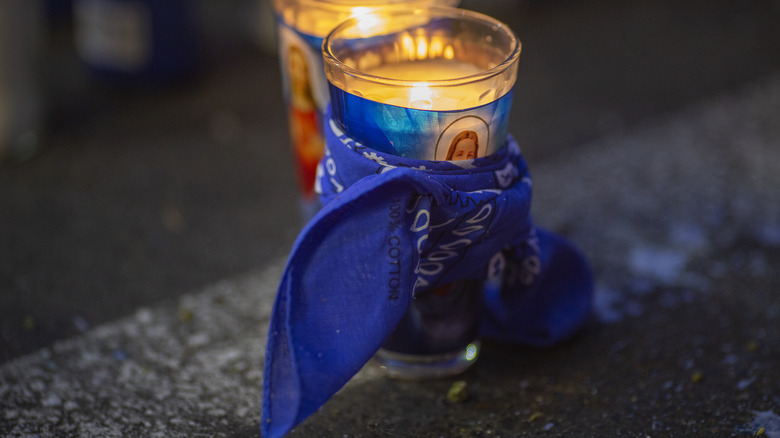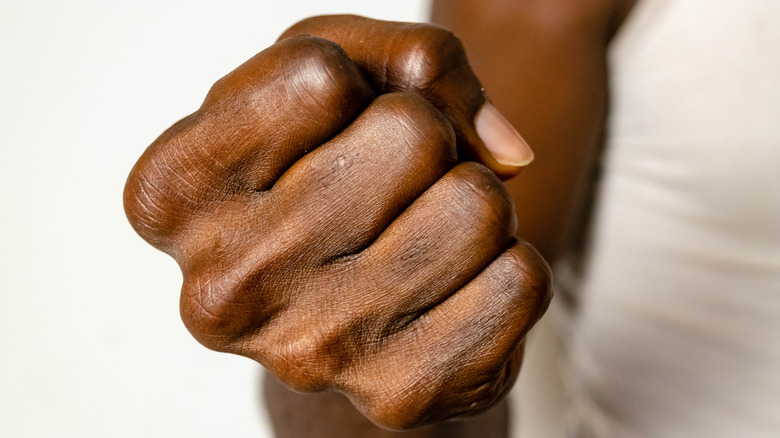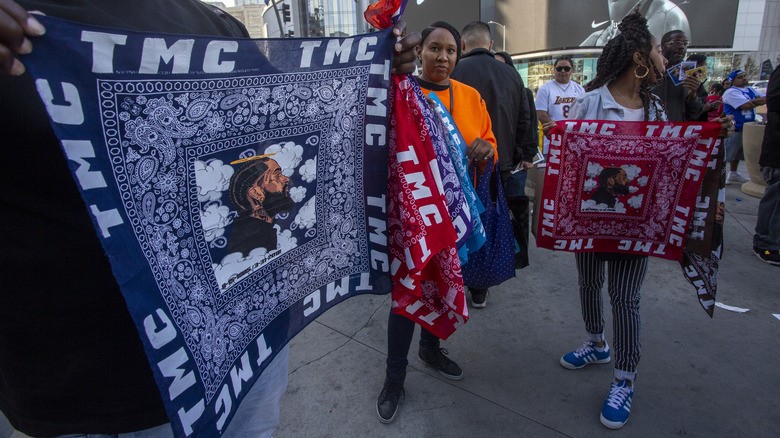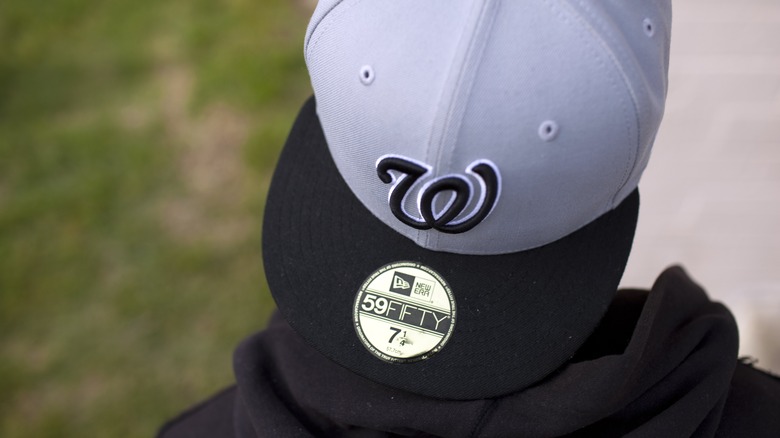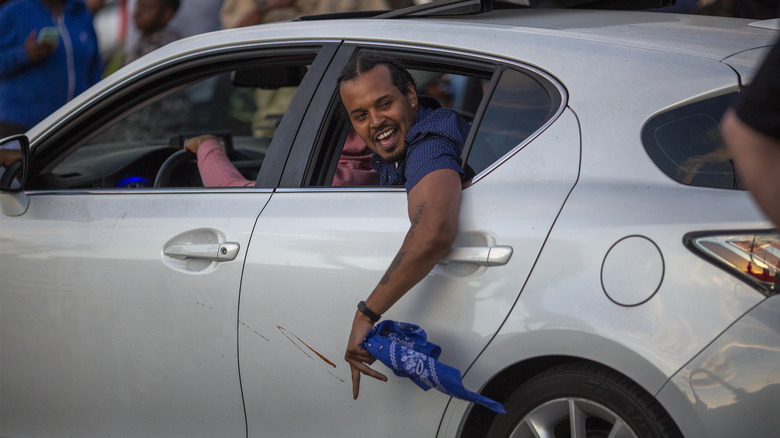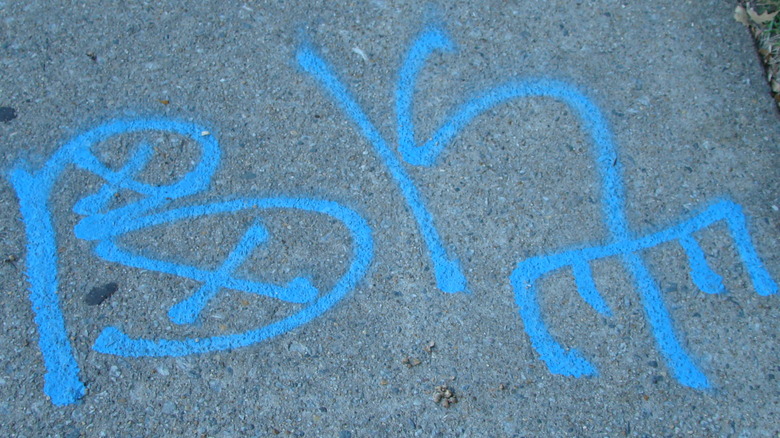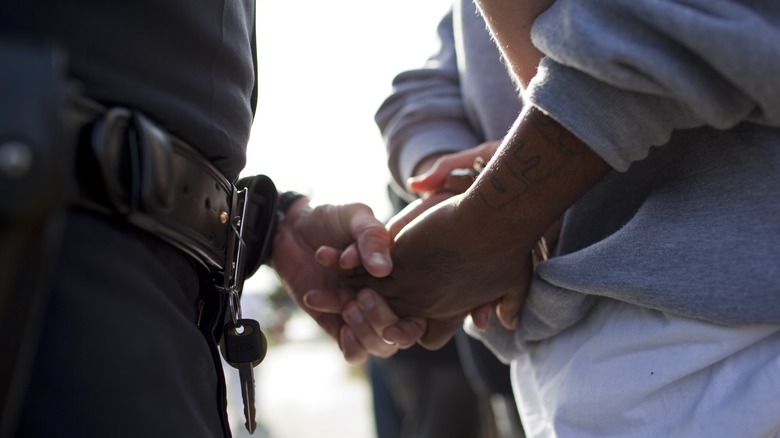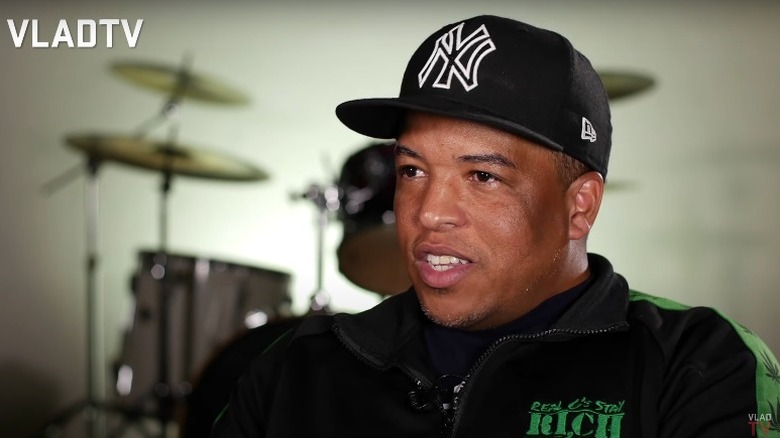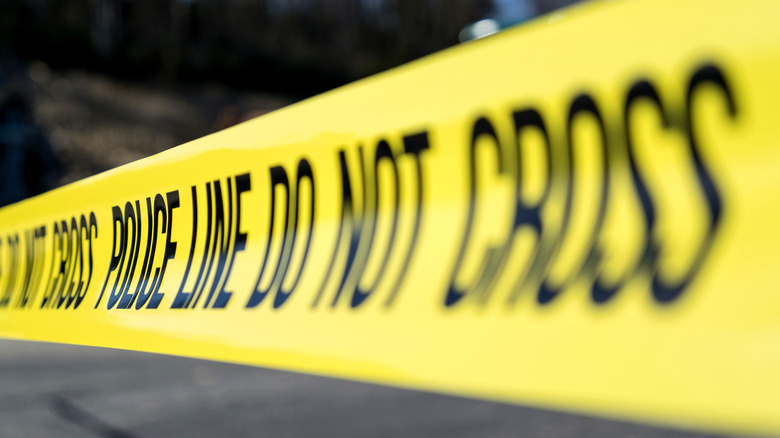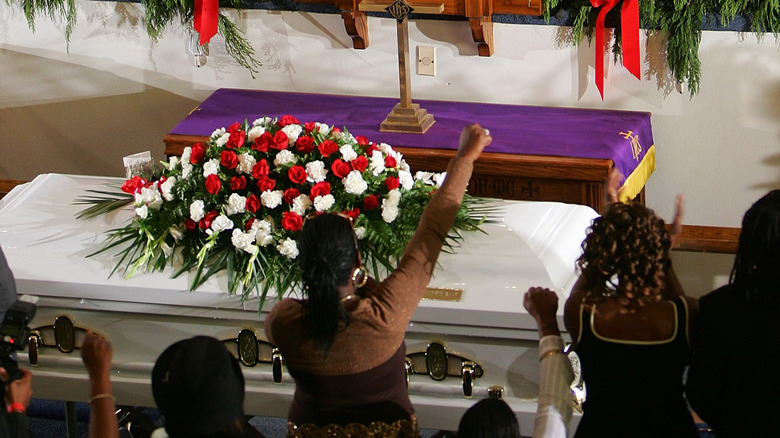Rules Crips Have To Follow
The Crips — along with their long-time rivals, the Bloods — are one of the most famous street gangs not just in the U.S., but in the world. According to Britannica, there's a lot that's just not known about them — including how they started. Some say the group was founded by high school students Stanley "Tookie" Williams and Raymond Washington, who were trying to organize a group that would help protect them and other students from the gang violence that dominated on the streets around them.
Another version of the story is that they started out as a political organization that had been inspired by the Black Panthers, but evolved over the years. It's also unclear just how the name came about, but regardless of what the true story behind the organization and the name is, it grew — a lot. In 2008, the Department of Justice estimated there were between 30,000 and 35,000 people with ties to the Crips. And they're not just based out of their home state of California anymore: The DoJ adds that groups were found in 41 states.
With that many different local gangs, there's bound to be some variations between the rules that members are expected to follow. Add in the fact that it can — for obvious reasons — be tough for an outsider to get an inside look, and it makes sense that understanding what's going on at street level isn't straightforward. Still, let's talk a little bit about what authorities know.
Here's what initiates have to go through
Joining a street gang isn't a decision that's taken lightly, and joining the Crips? That's definitely not a spur-of-the-moment thing. When Vice went along on the required initiation of a prospect-turned-member of Brooklyn's Silent Murder Crips, they learned pretty quickly that it wasn't for the faint of heart.
"I understand that initiation is super important," the prospect — identified as JT — explained. "It's love. You know? It's the key, you know what I'm saying? It's like... rite of passage."
JT was sent through a "three person square," which basically meant he stood in the middle and took a beating. The idea is that it shows prospects are tough enough to face whatever might come to them on the street, that they can handle themselves, and they're not going to back down from a fight.
Why would anyone opt to go through with this? JT also explained why he wanted to join, and for him, it was about not being alone on the streets anymore. It was about having a family, people who would have his back, and the clout that came with it. And he didn't see it as stepping into a world of risk — he was already living in that world, and he'd learned it the hard way when his sister was killed in a drive-by shooting.
According to the New York City Police Department, it's standard practice for members outside a set's original five founders, or those who aren't born into the gang.
Outsiders asking questions? Say nothing
This is by no means unique to the Crips, but it's still an important one that simply states that gang business stays in the gang, and members are expected to maintain a code of silence.
According to "Crips and Bloods: A Guide to an American Subculture," sharing inside information is forbidden, and snitching only ends in one of three ways: Being "robbed, stabbed, or killed." They quoted one anonymous gang member as explaining: "We are trained to keep our society a secret, never snitch, and protect your brother. Codes and conducts taught from an early age are embedded in us."
There are plenty of examples of how important this particular part of the code is, and the lengths members will go to in order to observe it. In 2020, The New York Times reported that up-and-coming rapper Pop Smoke had been arrested in connection with the theft of a 2019 Rolls-Royce worth around $375,000. In the following months, it was further reported (via Complex) that law enforcement was trying to leverage the arrest in order to get more information from him on not just the activities of the 823 Crips, but other Brooklyn gangs as well. He absolutely refused, with his lawyer adding, "It's something he would never entertain doing."
In the same year, the Associated Press reported that it wasn't long after Nipsey Hussle (pictured) told Eric Holder that he had been getting a reputation as a snitch that he was shot and killed.
Bloods are the enemy
There are a lot of famous feuds, and ranking up there at the top is the longtime rivalry between the Crips and the Bloods. That's led to some rules being put in place to avoid members of the Crips seeming to show allegiance, sympathy, or even indifference to Bloods, and they were outlined in information compiled by the New York Police Department.
Bloods aren't called Bloods, they're referred to as "slobs." It's forbidden for a Crip to wear red — the color traditionally associated with the Bloods — and after being initiated into the Crips and becoming a full member, one of the most widely respected ways to prove loyalty is by "drinking milk." That means targeting a Bloods member and beating, stabbing, or shooting that member. (Crips are, however, instructed to make sure the individual in question really is a Blood, and not just a "wannabee.")
Any time the letter "B" is written, there has to be a slash through it — it's meant to show disrespect. That's even true of the abbreviation BK, which stands for Blood Killer. That's exactly what it sounds like, and claiming to be one without actually having carried out the deed is verboten.
Still, truces are not unheard of and must be respected. According to the Los Angeles Daily News, Bloods and Crips have come to temporary agreements surrounding events like the 1992 LA riots that broke out after the beating of Rodney King, and more recently, after the death of Freddie Gray.
Certain offenses are considered violations
When Vice got a front-row seat at the initiation of a new member in Brooklyn's Silent Murder Crips, established members explained that the beating the prospect would endure was administered by a "three person square." It was a brutal moment that left the prospect — now a full-fledged member — walking away bloody, and it's not the only time a Crip might have to step into the center of his fellow gang members.
According to the New York City Police Department — and documents confiscated from a member of the United Gangsta Crips — there are several rules that are so important that breaking them earns a member a violation. Those rules include not showing up for a meeting (or showing up late), wearing red (a color associated with the rival gang, the Bloods), sharing information about gang business to someone on the outside, not observing the dress code (such as wearing appropriate colors), getting too friendly with rival gang members, fighting with a fellow gang member, or abandoning a fellow Crip.
Breaking any one of those rules would earn a violation, and when a member accumulated three violations, the confiscated documents explained, "you have to hit the square!"
Know the colors, slang, and numbers — and their meanings
Gang culture is ever-evolving, and according to Business Insider, one of the things that's changed is the dress code. In the 1980s and '90s, Crips members were expected to dress all in blue, but in more recent decades, that's changed for a very practical reason: It's easier to avoid attracting unwanted attention from law enforcement when your affiliation isn't on view for all to see.
The change was observed as early as 1988, when The New York Times reported that Crips who were moving into new territories were forgoing the traditional colors.
Colors remained important, though, and according to materials seized from a United Gangsta Crips member by the New York City Police Department, there were still colors that were off-limits. Red is forbidden, as it's associated with the Bloods, as was yellow, for an association with the Latin Kings. Members are required to know the meanings behind acceptable colors: They wear blue to signify their roles as soldiers, black for gangsters, purple for war, and green for money.
That's pretty straightforward, and more difficult are the code words and numbers gang members are required to learn. Those change regularly and are used to refer to things like weapons, locations, other gangs, and orders. The so-called "hand stacks," or hand gestures, are also required: They facilitate private communication in public spaces. Their meanings can regularly change, too.
Learn lessons: Verbatim
Given the content of communications, it's not entirely surprising that Crips might want to keep private messages private — and according to documents seized from a member of the United Gangsta Crips (via the New York City Police Department), that means learning and using a specific version of the alphabet. Individual letters can vary between the different sets of Crips, but the idea is the same: Hieroglyphic-like symbols represent the letters of the alphabet, and a numbered alphabet corresponds to words associated with Crip ideology. (That includes things like J for Justice, V for Victory, and W for Wisdom.)
It's all for practical reasons. Two of the most common places these code words, letters, and numbers show up is in graffiti and tattoos. Members who have meanings memorized can read it at a glance and learn exactly who they're with, what turf they're on, or what boundaries they're about to cross.
There are also a series of "lessons" that each member is required to learn and be able to recite verbatim. Most of these are short sayings or verses that invoke the history of the gang or their ideology, and the NYPD gives examples such as: "Why is the sky blue? 'Cause all Crips go to heaven and all slobs (Bloods) go to hell."
Among the NYPD's list is a "Crip prayer": "When I die, show no pity. Bury my soul in Gangsta City, lay two C's across my chest, and tell King Hoover I did my best."
Kids can leave
It's often repeated that once someone joins the Crips, they're in it for life. According to research done in "Gang Wars: The Failure of Enforcement Tactics and the Need for Effective Public Safety Strategies" (via the Justice Policy Institute), that's not exactly the case.
They found that a large number of people who fall in with street gangs do so when they're between 12 and 15 years old, although it isn't unheard of for some gangs to recruit 11-year-olds. They also say that many lose interest within the year, and for the most part, they're allowed to simply walk away. (It's likely, however, that they will continue to be associated with the street gang they joined, and be targeted by rival gangs.)
That was an idea confirmed by joint research from the University of Colorado Boulder and Arizona State University (via The Conversation), which indicates it's harder to leave a gang in prison than on the street.
Criminologists from Erasmus University Rotterdam looked at The Hague's Dutch Rollin' 20 Crips, and members that wanted to leave. Most, they found, were able to simply walk away. (The most commonly cited reason for leaving was a growing disillusionment with life on the inside of a gang not being quite what was expected.) There was still the idea of "blood in, blood out," "Tru Blu to the Casket," "Crip or Die," and the threat of violence at defection, but reality — both in European and American Crip sets — was often much different.
Don't be gay
Vlad TV sat down to talk to rapper and Crip BG Knocc Out (pictured) on some of the gang rules, and he summed it up pretty clearly: "The code to gang-banging is you can't be [gay] or a snitch."
He went on to say that it was a part of the 1974 "G code," and it was a rule that was around before gangs even separated into different entities. It pre-dated the Crips vs. the Bloods, and when asked whether or not there were any gay men in gangs today, he replied, "Who are they? We don't accept them."
Vanessa R. Panfil is an assistant professor of Sociology and Criminal Justice at Old Dominion University and the author of "The Gang's All Queer," an in-depth look at the lives of gay and bisexual gang members. She found that many were very careful to keep their private life strictly separate from their gang life. Many feared retaliation, or being forced out of the gang by being "bled out," or challenged to a fight and kicked out at the end. She wrote (via The Conversation) that in straight gangs like the Crips, the closet door needed to stay firmly locked.
Retaliation is taken very, very seriously
Campus Safety Magazine describes the "3 Rs" of gang life as Reputation, Respect, and Retaliation. Those are concepts the Crips take very seriously, and if Crip reputation is harmed or respect isn't shown, retaliation will follow.
According to "Gang Investigations," there are any number of reasons a gang might decide retaliation is necessary, ranging from things like an assault on one of their members to even suffering an embarrassment. The idea is that each of these incidents chips away at their reputation, and that reputation has to be restored at all costs.
That goes all the way to the top. In 2018, the United States Attorney's Office for the Southern District of New York issued a press release stating that Crips leader Rubin "Nut" Moye had been sentenced to 16 years in prison for a combination of firearms possession (while having previous felony convictions) and witness retaliation, for ordering an assault on someone who might testify against him in court.
In 2021, the same office announced that a member of the T&A Crips set had been convicted of killing a member of a rival gang — the Milo Bloods — in retaliation for a Blood driving into Crip territory. Then, in 2022, the Los Angeles Times reported that nine members of the Kitchen Crips had been arrested in connection with attacks of retribution targeting Bloods, which killed several civilian bystanders.
You go to the funerals of your fellow Crips
When it comes time to bury a member of a Crips set, it's understood that surviving gang members will attend the funeral, show respect, and send them off right.
In 1992, the Los Angeles Times reported that the 17-mile-long turnout for Crips' OG James "Cadillac Jim" Shelton was so great that law enforcement found themselves stretched thin, trying to keep a watchful eye over the entirety of the proceedings — which were deemed a prime target for retaliatory attacks. Former gang member Gregory Williams explained why attending funerals was so important: "You go to the funeral out of respect ... This is what you have been fighting and dying for. ... In a gang, you die for your neighborhood."
The Washington Post reported that when Crips founder Stanley Tookie Williams was buried in 2005, thousands of people showed up to pay their respects and turned the funeral (pictured) into a standing-room-only event. In 2008, The Denver Post reported on the funeral of Michael Asberry. At the time, most of the gang violence on the streets of Denver was between sets — and different generations — of Crips, but gang leaders called a temporary truce to allow members to pay their respects to their shared founder.
In 2012, the Portland Tribune reported that the city's religious leaders had gotten together to enter into a covenant that declared funerals off-limits to behavior designed to provoke a response from rival gangs. Several recent funerals had escalated into conflicts that led to more deaths, and after the declaration, they said they were hopeful that it had been a start.
